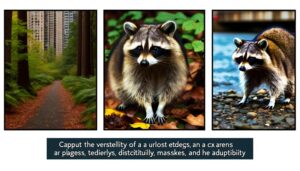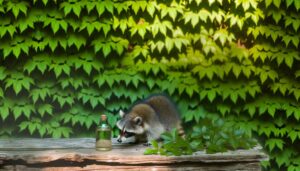Do Raccoons Live in Palm Trees?
Yes, raccoons do live in palm trees, especially in urban areas. These adaptable creatures utilize palm trees for nesting and protection.
Their remarkable climbing abilities allow them to navigate the fronds effectively. In urban settings, palm trees provide elevated, safe nesting sites away from predators and human activity.
However, palm trees present certain challenges, such as limited protection against extreme weather and dehydration risks due to water scarcity. Despite these challenges, raccoons' nocturnal habits and problem-solving skills aid in their survival.
Discover more about their fascinating urban adaptations and behaviors.

Key Takeaways
- Raccoons utilize palm trees for nesting and protection in urban environments.
- Their adept climbing skills enable raccoons to navigate and inhabit palm trees.
- Palm trees provide elevated and safe nesting sites for raccoons.
- Nocturnal behavior of raccoons reduces human encounters in palm tree habitats.
- Palm trees offer limited protection and present challenges in extreme weather conditions.
Raccoons' Natural Habitats

Raccoons (Procyon lotor) primarily inhabit deciduous and mixed forests, but they exhibit remarkable adaptability to various environments including urban areas and coastal regions.
In their natural habitats, raccoons thrive in areas abundant with water sources such as rivers, lakes, and streams, which provide essential hydration and food resources. They are nocturnal foragers, utilizing their dexterous front paws to search for a diverse diet comprising fruits, nuts, insects, and small vertebrates.
Raccoons often establish dens in hollow trees, logs, or abandoned burrows, which offer protection from predators and harsh weather conditions. Their climbing proficiency allows them to navigate through treetops efficiently, making arboreal habitats particularly advantageous for foraging and nesting.
This adaptability underscores their resilience and survival across varied ecosystems.
Adapting to Urban Environments
As raccoons increasingly inhabit urban environments, they exhibit remarkable adaptability in their survival strategies, food source preferences, and shelter choices.
They utilize anthropogenic resources, often foraging through human waste, and seek nesting sites in man-made structures or vegetation such as palm trees.
This behavioral flexibility underscores the species' ability to thrive amidst urbanization.
Urban Survival Strategies
Adapting to urban environments, raccoons exhibit remarkable flexibility in their behavior and habitat selection, with palm trees providing an unexpected yet effective refuge amidst city landscapes. This adaptability is showcased through several urban survival strategies:
- Nesting Habits: Raccoons utilize palm trees for nesting, taking advantage of their height and foliage for protection against predators and human activity.
- Nocturnal Activity: By being primarily nocturnal, raccoons minimize encounters with humans and can exploit urban resources with less competition.
- Climbing Ability: Their adept climbing skills allow them to navigate vertical structures like buildings and trees, broadening their potential habitats.
- Resource Utilization: Raccoons exploit diverse urban resources, from shelter to water sources, demonstrating their capacity to thrive in varied environments.
Such strategies underscore their resilience and adaptability.
Food Sources Adaptation
Building on their impressive urban survival strategies, these adaptable mammals also exhibit remarkable ingenuity in sourcing food within city environments. Raccoons (Procyon lotor) have adapted to exploit a variety of urban food sources, ranging from scavenging through garbage bins to foraging in parks and residential gardens. Their omnivorous diet allows them to consume fruits, vegetables, insects, and small animals, aiding their survival in diverse urban landscapes.
Observations indicate that raccoons utilize their dexterous forepaws to access tightly sealed containers, demonstrating problem-solving abilities. Additionally, raccoons have been noted to take advantage of human-provided resources, such as pet food left outdoors. This behavioral flexibility in food acquisition underscores their success in thriving amidst urbanization, effectively bridging natural and anthropogenic food sources.
Shelter and Nesting Choices
Raccoons exhibit remarkable adaptability in urban environments by selecting a diverse array of nesting sites, which include attics, chimneys, abandoned buildings, and particularly, the canopies of palm trees. This flexibility in shelter choice allows raccoons to thrive in areas with high human activity.
Key observations on their nesting preferences include the following:
- Elevated Locations: Raccoons often choose elevated sites to avoid predators and human disturbances.
- Accessibility: Urban structures like chimneys provide easy access and protection.
- Concealment: Dense foliage in palm trees offers effective concealment from both predators and humans.
- Proximity to Resources: Nesting sites are usually close to water sources and food supplies, facilitating their daily needs.
These strategic choices underscore raccoons' ability to adapt and survive in urban landscapes.
Palm Trees as Shelter

Nestled within the fronds and trunks of palm trees, raccoons find a unique and advantageous shelter that offers both protection and elevation. These arboreal environments provide raccoons with a natural barrier against ground-level predators and harsh weather conditions.
The dense canopy of fronds creates a concealed habitat, while the trunk's cavities and crevices serve as ideal nesting sites. Observations indicate that raccoons utilize these elevated positions to monitor their surroundings, enhancing their ability to detect potential threats.
In addition, palm trees' structural complexity provides multiple entry and exit points, facilitating swift escape routes. Through meticulous adaptation, raccoons have effectively leveraged the architectural features of palm trees, making them a preferred choice for shelter.
Benefits of Palm Trees
The architectural features of palm trees not only provide raccoons with shelter but also offer a range of ecological benefits that support various species and contribute to the health of their ecosystems.
These benefits include:
- Habitat Creation: Palm trees offer nesting sites and food resources for birds, insects, and small mammals.
- Soil Stabilization: Their root systems help prevent soil erosion, maintaining the integrity of coastal and inland ecosystems.
- Carbon Sequestration: Palms absorb CO2, playing a role in mitigating climate change.
- Biodiversity Support: They provide a microhabitat that sustains a variety of flora and fauna, enhancing overall biodiversity.
Through these functions, palm trees significantly contribute to ecological balance and the sustenance of diverse biological communities.
Risks and Challenges

The adaptation of raccoons to living in palm trees presents several risks and challenges. This includes increased vulnerability to predators and natural threats. The suitability of palm trees as a habitat may be compromised by their structural limitations and availability.
Furthermore, raccoons must contend with climatic adaptability constraints that can affect their survival and overall health.
Predators and Natural Threats
Raccoons residing in palm trees face a variety of predators including birds of prey, snakes, and larger mammals, each posing significant threats to their survival. These predators capitalize on the raccoons' arboreal habitats and nocturnal behaviors.
Key threats include:
- Birds of Prey – Hawks and owls can snatch young raccoons from tree branches.
- Snakes – Large constrictors may climb palm trees to prey on raccoons.
- Larger Mammals – Coyotes and bobcats can catch raccoons when they descend.
- Human Activity – Urbanization increases encounters with domestic pets and vehicles.
These natural threats necessitate constant vigilance and adaptive behaviors for raccoons to thrive in such environments. Understanding these risks underscores the challenges they face daily.
Habitat Suitability Issues
Habitat suitability for raccoons in palm trees is influenced by several critical factors that present both risks and challenges to their survival and well-being.
First, the structural integrity of palm trees may not support the weight and nesting behaviors of raccoons, leading to potential falls or injuries.
Second, limited food sources in palm tree environments could result in nutritional deficiencies.
Another concern is the exposure to human activity, as palm trees are often located in urban areas, increasing the likelihood of human-wildlife conflicts.
Additionally, the lack of adequate shelter within palm trees may expose raccoons to predators and harsh weather conditions.
These elements collectively underscore the complexities and hazards associated with raccoons inhabiting palm trees.
Climatic Adaptability Constraints
In regions with significant temperature fluctuations, raccoons residing in palm trees face considerable challenges in maintaining homeostasis. These arboreal habitats offer limited protection against extreme weather conditions, making climatic adaptability essential.
Raccoons must contend with:
- Thermoregulation: Palm trees provide minimal insulation, exposing raccoons to heat stress during high temperatures and hypothermia during cold spells.
- Hydration: Limited water sources in palm tree environments increase the risk of dehydration, especially in arid climates.
- Food Scarcity: Seasonal variations can lead to food shortages, impacting raccoon health and survival.
- Predation Risk: Adverse weather can force raccoons to leave the relative safety of palm trees, increasing their vulnerability to predators.
These factors collectively underscore the significant climatic adaptability constraints raccoons face in palm tree habitats.
Observing Raccoons in Palm Trees
Researchers have meticulously documented the behaviors and interactions of raccoons as they navigate and inhabit palm trees, providing valuable insights into their arboreal adaptations. Observations reveal that raccoons exhibit remarkable climbing abilities, leveraging the rough texture and segmented structure of palm trunks for secure ascent and descent.
Their dexterous paws enable them to grasp and manipulate palm fronds effectively, facilitating movement and foraging. Nesting behaviors have also been noted, with raccoons creating dens within the natural cavities formed by dead fronds. Moreover, their nocturnal activity patterns align with the cooler, predator-scarce hours, optimizing survival.
These detailed observations underscore the raccoon's versatility and adaptability in utilizing palm trees as both shelter and resource hubs in suitable habitats.
Conclusion
Raccoons, typically inhabitants of forests and marshes, have demonstrated remarkable adaptability, thriving in urban environments and utilizing palm trees as shelter. Palm trees offer numerous benefits, such as elevated safety and ample nesting opportunities.
While some may argue that palm trees present unique challenges like limited food resources, raccoons' opportunistic feeding behaviors mitigate these risks. Observations confirm that raccoons efficiently exploit palm trees, underscoring their adaptability and resourcefulness in diverse habitats.






